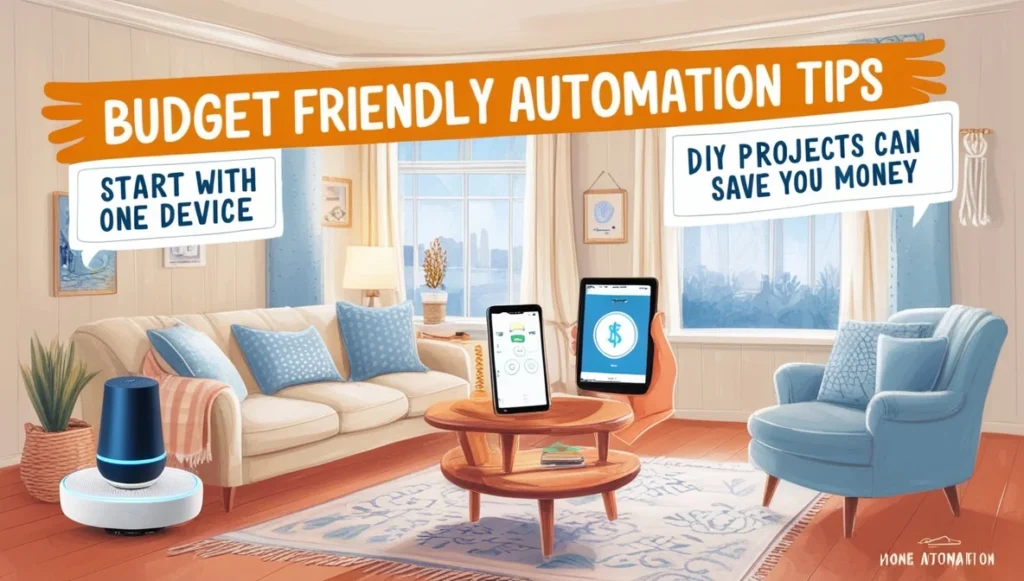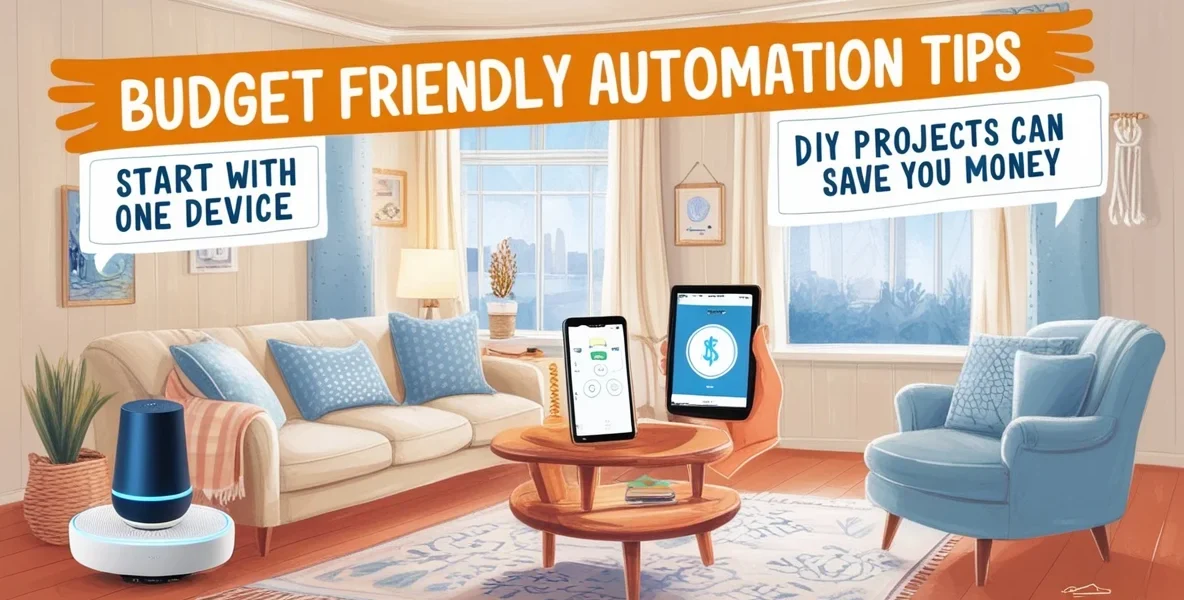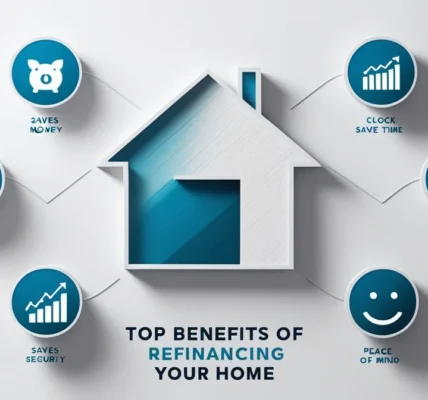Maximizing Smart Home Savings: How to Cut Costs with Home Automation
Budget home automation tips Home automation can seem like a costly endeavor, but with the right strategies, you can achieve significant savings. By integrating energy-efficient devices, utilizing smart thermostats, and optimizing your home’s energy usage, you can reduce your utility bills. Additionally, taking advantage of rebates and incentives offered by energy companies can further lower your costs.
Budget Home Automation Tips-Start by investing in smart light bulbs and plugs that allow you to control your lighting and appliances remotely. These devices help you avoid unnecessary energy consumption by turning off lights and appliances when not in use. Another key area to focus on is your heating and cooling system. Smart thermostats learn your schedule and adjust the temperature accordingly, ensuring that your home is comfortable without wasting energy.

Budget Home Automation Tips Moreover, consider installing smart water leak detectors and automated irrigation systems. These devices can help you save water and prevent costly damage from leaks. By monitoring your water usage and automating your irrigation, you can ensure that your home is both efficient and environmentally friendly.
Budget Home Automation Tips Additionally, smart home security systems can also contribute to savings. By installing smart cameras and sensors, you can monitor your home remotely, reducing the need for costly security services. These systems often come with features like motion detection and real-time alerts, providing an extra layer of security without the high price tag.
Budget Home Automation Tips Lastly, consider using smart power strips to manage your electronic devices. These strips can detect when a device is in standby mode and cut off power, preventing phantom energy consumption. This small change can lead to significant savings over time, especially if you have multiple electronic devices in your home – To follow the latest updates, visit newsnaw.com or follow us on X and Facebook.
Budget Home Automation: Affordable Solutions to Modernize Your Home
Budget Home Automation Tips Transforming your home into a smart home doesn’t have to be expensive. There are numerous budget-friendly options available that can help you modernize your living space without breaking the bank. Start by prioritizing the areas of your home that will benefit the most from automation, such as security, lighting, and climate control.
For security, consider installing affordable smart doorbells and cameras that allow you to monitor your home remotely. These devices provide peace of mind and can be easily integrated with your existing security system. Additionally, smart locks offer a convenient and secure way to control access to your home.
Budget Home Automation Tips When it comes to lighting, smart bulbs and plugs are a cost-effective way to automate your home. These devices can be controlled via smartphone apps, allowing you to create schedules and scenes that enhance your home’s ambiance. For climate control, smart thermostats and fans can help you maintain a comfortable environment while reducing energy costs.
Budget Home Automation Tips Another affordable solution is to invest in smart home hubs. These hubs act as a central control point for all your smart devices, allowing you to manage them from a single app. Many budget-friendly hubs are available on the market, making it easy to integrate and control your smart home devices without spending a fortune.
Budget Home Automation Tips Additionally, consider using smart sensors to automate various aspects of your home. Motion sensors can trigger lights to turn on when you enter a room, while door and window sensors can alert you if they are left open. These small, affordable devices can make a big difference in the convenience and security of your home.
Budget Home Automation Tips Lastly, don’t overlook the power of smart home assistants like Amazon Alexa or Google Assistant. These devices can control your smart home devices, provide information, and even play music, all through voice commands. They are relatively inexpensive and can significantly enhance your smart home experience.
Smart Home Tips: Essential Advice for Every Budget-Conscious Homeowner
Budget Home Automation Tips Creating a smart home on a budget requires careful planning and strategic investments. Here are some essential tips to help you get started:
1. Start small: Begin with a few key devices that offer the most significant benefits, such as smart thermostats, lights, and security cameras. As you become more comfortable with the technology, you can gradually expand your system.
2. Look for deals and discounts: Keep an eye out for sales, promotions, and discounts on smart home devices. Many retailers offer special deals during holidays and events, making it easier to find affordable options.
3. Choose compatible devices: Ensure that the devices you purchase are compatible with each other and can be easily integrated into a single system. This will make it easier to control and manage your smart home.
4. DIY installation: Save money by installing devices yourself instead of hiring a professional. Many smart home devices come with easy-to-follow instructions and online tutorials that can guide you through the process.
5. Utilize free apps and services: Take advantage of free apps and services that allow you to control and monitor your smart home devices. These tools can help you maximize the benefits of your smart home without additional costs.
6. Prioritize energy efficiency: Focus on devices that offer energy-saving features, such as smart thermostats, bulbs, and plugs. These devices can help you reduce your utility bills and make your home more environmentally friendly.
7. Integrate with existing systems: Choose smart home devices that can be easily integrated with your existing systems, such as security cameras and lighting. This will help you create a cohesive and efficient smart home setup.
8. Plan for future expansion: As you build your smart home, consider how you can expand your system in the future. Choose devices that are compatible with a wide range of other smart home products.
Home Automation Guide: Step-by-Step Instructions for a Budget-Friendly Smart Home
Budget Home Automation Tips Creating a budget-friendly smart home involves a step-by-step approach that ensures you make the most of your investments. Follow this guide to get started:
Step 1: Budget Home Automation Tips Assess your needs – Determine which areas of your home will benefit the most from automation. Consider factors such as security, energy efficiency, and convenience.
Step 2: Set a budget – Establish a budget for your home automation project. This will help you prioritize your purchases and avoid overspending.
Step 3: Research devices – Look for affordable smart home devices that meet your needs. Read reviews and compare features to find the best options within your budget.
Step 4: Plan your installation – Create a plan for installing your smart home devices. Consider factors such as placement, connectivity, and compatibility with other devices.
Step 5: Install and configure – Follow the manufacturer’s instructions to install and configure your devices. Take your time to ensure everything is set up correctly and functioning as intended.
Step 6: Monitor and optimize – Regularly monitor your smart home system to ensure it is working efficiently. Make adjustments as needed to optimize performance and achieve the desired results.
Step 7: Seek professional advice if needed – If you encounter any difficulties or have specific requirements, don’t hesitate to seek professional advice. Many smart home experts offer consultations and can help you make the most of your budget-friendly smart home setup.
Cheap Home Automation: Cost-Effective Gadgets and Systems
Budget Home Automation Tips There are plenty of cost-effective gadgets and systems available that can help you create a smart home without breaking the bank. Here are some affordable options to consider:
1. Smart plugs: These inexpensive devices allow you to control your appliances remotely and set schedules to save energy.
2. Smart bulbs: LED smart bulbs are energy-efficient and can be controlled via smartphone apps, making it easy to adjust lighting to suit your needs.
3. Smart thermostats: These devices learn your schedule and preferences, helping you maintain a comfortable home while reducing energy costs.
4. Smart security cameras: Affordable security cameras provide remote monitoring and can be integrated with other smart home devices for enhanced security.
5. Smart locks: These devices offer a convenient and secure way to control access to your home, eliminating the need for traditional keys.
6. Smart speakers: Voice-activated smart speakers can control various smart home devices, play music, and provide information, making them a versatile addition to your home.
7. Smart sensors: Motion sensors, door/window sensors, and water leak detectors are cost-effective devices that can enhance your home’s security and efficiency.
8. Smart home hubs: Affordable smart home hubs can centralize control of your devices, making it easier to manage and automate your home.
9. DIY smart home kits: These kits provide all the necessary components to get started with home automation and are often more cost-effective than purchasing individual devices.
Home Automation Tips: Practical Strategies for Enhancing Your Home on a Budget
Budget Home Automation Tips Enhancing your home with automation doesn’t have to be expensive. Here are some practical strategies to help you achieve a smart home on a budget:
1. Focus on high-impact areas: Prioritize areas of your home that will benefit the most from automation, such as security, lighting, and climate control.
2. Use multi-purpose devices: Invest in devices that offer multiple functions, such as smart speakers that can control other devices, play music, and provide information.
3. Take advantage of energy-saving features: Budget Home Automation Tips Look for devices with energy-saving features, such as smart thermostats and bulbs, to reduce your utility bills.
4. Integrate with existing systems: Choose smart home devices that can be easily integrated with your existing systems, such as security cameras and lighting.
5. Plan for future expansion: As you build your smart home, consider how you can expand your system in the future. Choose devices that are compatible with a wide range of other smart home products.
6. Utilize free resources: Budget Home Automation Tips Take advantage of free online tutorials, forums, and communities to learn more about smart home technology and get tips from other budget-conscious homeowners.
7. Regularly update your system: Keep your smart home devices updated with the latest firmware and software to ensure they are running efficiently and securely.
8. Monitor your energy usage: Use smart home apps to monitor your energy consumption and identify areas where you can save money.
Minimalist Office Design Ideas: Integrating Home Automation for a Sleek Workspace
Budget Home Automation Tips Creating a minimalist office design involves integrating home automation to enhance functionality and maintain a sleek, clutter-free workspace. Budget Home Automation Tips Here are some ideas to help you achieve this:
1. Smart lighting: Use smart bulbs and light strips to create a well-lit workspace that can be adjusted to suit your needs. This helps reduce eye strain and improve productivity.
2. Cable management: Use wireless charging pads and smart power strips to minimize cable clutter on your desk. This creates a clean and organized workspace.
3. Smart speakers: Integrate smart speakers into your office to control other devices, play music, and provide information without the need for additional equipment.
4. Automated climate control: Use smart thermostats and fans to maintain a comfortable temperature in your office, ensuring a productive work environment.
5. Security: Install smart locks and cameras to secure your office space and protect your equipment. This provides peace of mind and allows you to focus on your work.
6. Ergonomic furniture: Choose ergonomic furniture that complements your minimalist design and enhances comfort. Look for adjustable desks and chairs that can be easily integrated with your smart home system.
7. Smart storage solutions: Budget Home Automation Tips Use smart storage solutions, such as automated filing cabinets and smart shelves, to keep your office organized and clutter-free.
8. Voice-activated assistants: Incorporate voice-activated assistants into your office to control devices, set reminders, and manage your schedule without the need for physical interaction.




